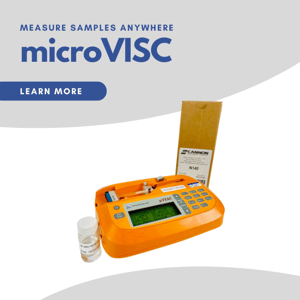
Thank You - Viscosity of Corn Syrup as a Function of Concentration and Temperature
Application Note
microVISC™: Temperature Dependent Viscosity Study
Gregory E. Ogden, PhD Department of Chemical & Environmental Engineering University of Arizona
Objective: This study was carried out to determine the viability of using the RheoSense microVISC™ to record temperature dependent viscosity data using various solutions of water and corn syrup at three temperatures. The collected data followed trends seen in similar studies analyzing viscosity of various syrups.

Materials: Distilled water used in these experiments came from the commercial brand Nice!. The syrup used was Light Corn Syrup from Kroger Foods. 70% isopropyl alcohol from CVS was used to clean the viscometer. The viscometer used was RheoSense microVISC™ (HVROC-L). The cartridge on the viscometer was a VROC® chip (HA02-01). The software used to analyze data was Microsoft Excel 2013.


Procedure: To test the viscometer, nine 10 mL solutions of distilled water and corn syrup were prepared on volume per volume basis ranging between 100% distilled water to 10% distilled water. Solutions were prepared with 3 mL syringes. Viscosity measurements were taken in three different environments where the room temperature averaged 13.8, 19.6, and 26.5 °C. The experiments were carried out on different days and new sets of solutions were prepared for each of the three temperatures.
The solutions and viscometer were allowed to acclimate to the ambient temperature for half an hour prior to taking measurements. Four measurements were taken for each range of solutions at each temperature; however, the first measurement was not recorded. The first measurement was considered a ‘prime’. This “priming” was done to reduce contamination from the prior solution used.
After carrying out experiments with three solutions (12 measurements), the instrument underwent two cleaning cycles with distilled water. The measurements were taken in order of least viscous solution to most viscous starting with the 100% distilled water solution and ending with the 10% distilled water solution. After the final set of measurements at a particular temperature, the unit underwent three cleaning cycles. The first with 70% Isopropyl alcohol, and the final two with distilled water. All data measurements were taken with the viscometer in Automatic mode.
Analysis: It has been observed that other syrups such as kokum, mango pulp, and apple syrup follow a simple Arrhenius model [1]:

Equation 1: η: viscosity, T: absolute temperature, R: gas constant Ea and A0: constants [1].

To determine whether the data in this experiment fit this trend, the natural log of the viscosity for each temperature was plotted against the inverse of the temperature as described by a simplified linearization of the Arrhenius model:

Equation 2: η: viscosity, T: absolute temperature, A and B: constants (Hrma 2008).
The average viscosities of each concentration were plotted against the average temperature range of the experiments seen in Figure 1. As can be seen in Figure 2, the data also follows linear trends following suit with the syrups in Swami’s study.

As the concentration of water decreases, the viscosity of the solution increases within a temperature range as can be seen in Figure 2. This was also observed in Beckett’s study with golden syrup and water across solutions of 100, 90, and 60 % golden syrup in water at 13 °C [2].
At fixed solution concentrations against different temperatures, we observe that the slope of the linearized plots increases as the concentration of water decreases seen in Table 1. This makes sense as the slope in the Arrhenius model relates to the activation energy, in this case the energy required for the liquid to flow. It makes sense that higher concentrations of corn syrup will lead to more viscous solutions and require more energy establish a flow.

Conclusion: The trends in the viscosity data acquired with the microVISC™ across different temperatures and concentrations follow those seen in other studies [1-4]. Combined with the trends in activation energy found from data fitted to an Arrhenius model shows that the viscometer can deliver reliable temperature dependent viscosity data.
References:
1. Swami, Shrikant Baslingappa, Nayan Singh Thakor, and Seema S. Wagh. "Effect of temperature on viscosity of kokum, karonda, mango pulp and cashew apple syrup." Agricultural Engineering International:
CIGR Journal15.4 (2013): 281-287.
2. Beckett, F. M., et al. "An experimental study of low Reynolds-number exchange flow of two Newtonian fluids in a vertical pipe." Journal of Fluid Mechanics 682 (2011): 652-670.
3. Hrma, Pavel. "Arrhenius model for high-temperature glass-viscosity with a constant pre-exponential factor." Journal of Non-Crystalline Solids 354.18 (2008): 1962-1968.
4. Seeton, Christopher J. "Viscosity-temperature correlation for liquids."STLE/ASME 2006 International
Joint Tribology Conference. American Society of Mechanical Engineers, 2006.
Contact:
If you have questions or would like more information about this product or other applications, please contact us:
Main office — 1 (925)-866-3801
Information — info@rheosense.com
Sales — sales@rheosense.co
.png?width=200&height=58&name=RheoSense%20Logo%20(REGISTERED).png)

.png?width=302&height=302&name=Temp%20Dependent%20Viscosity%20of%20Cannibis%20initium%20one%20plus%20App%20Note%20Tile%20(small).png)






-1.png?width=300&name=Mayo%20Viscosity%20m-VROC%20II%20App%20Note%20Tile%20(small)-1.png)